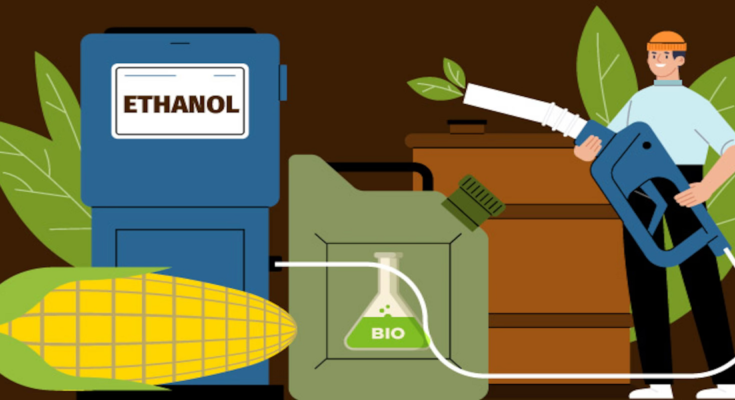India Ethanol Market was valued at USD 6512.27 Million in 2023 and is anticipated to project robust growth in the forecast period with a CAGR of 16.06% through 2029. Ethanol is a renewable fuel made from various plant materials collectively known as “biomass”. Ethanol’s lower carbon intensity compared to conventional fuels has led to a reduction in carbon emissions, contributing to India’s efforts to meet its climate goals.
Along with this, the Indian government’s resolute push for ethanol blending in petrol has been a game-changer. The Ethanol Blended Petrol (EBP) program, which started in 2003, mandates the blending of ethanol with petrol to reduce greenhouse gas emissions and promote cleaner fuels. The government’s commitment to achieve 20% ethanol blending in petrol by 2025 has provided a strong impetus to ethanol production.
Moreover, the government’s support through incentives, subsidies, and grants has encouraged investment in ethanol production infrastructure. These incentives have stimulated the interest of both public and private entities, resulting in increased capacity and output. Furthermore, ethanol production provides an additional revenue stream for farmers, contributing to rural economic development. The promotion of ethanol acts as a bridge between agriculture and energy sectors, enhancing farmer welfare while advancing energy security. All these factors contribute to the growth of the India Ethanol Market in the forecast period.
Key Market Drivers
Rising Demand for Biofuels for Sustainable Development
In recent years, the world has witnessed a growing awareness of the pressing need to transition towards sustainable energy sources, driven by concerns over climate change, dwindling fossil fuel reserves, and the imperative to mitigate environmental degradation. In line with this global shift, India has emerged as a frontrunner in adopting alternative energy solutions, with a particular focus on biofuels as a key component of its sustainable development strategy.
Download FREE Sample Report @ https://www.techsciresearch.com/sample-report.aspx?cid=3860
Within the realm of biofuels, ethanol has gained prominence as a cleaner and greener alternative to traditional fossil fuels. The rising demand for biofuels, particularly ethanol, in India’s pursuit of sustainable development presents a paradigm shift in the country’s energy landscape. Moreover, India’s burgeoning population, rapid industrialization, and urbanization have led to an exponential increase in energy consumption.
The country heavily relies on imported fossil fuels to meet its energy demands, making it vulnerable to global price fluctuations and geopolitical uncertainties. Additionally, the burning of fossil fuels contributes significantly to greenhouse gas emissions, exacerbating the challenges of climate change and air pollution. To address these multifaceted issues, India has committed to ambitious goals outlined in the Paris Agreement, which includes a significant reduction in carbon emissions and an increase in the share of renewable energy in its energy mix.
To support this agreement, focus on sources of energy that are generated from renewable feedstock such as ethanol which is a renewable biofuel derived from organic matter such as sugarcane, corn, and various cellulosic feedstocks, has garnered attention as an effective way to mitigate the adverse environmental impacts of conventional fuels by emitting fewer greenhouse gases as compared to traditional gasoline. Therefore, the increasing demand for biofuels for sustainable development led to the growth of India Ethanol Market in the forecast period.
Favorable Policies by Government
In the wake of global calls for a more sustainable and eco-friendly approach to energy consumption, the Indian government has taken noteworthy strides to promote the production and utilization of ethanol as an alternative fuel. With a strategic focus on reducing carbon emissions, decreasing dependency on fossil fuels, and ensuring energy security, India has put in place a series of favorable policies that have not only stimulated the growth of the ethanol industry but also positioned the country as a pioneer in sustainable energy transitions. One of the cornerstones of India’s ethanol push is the implementation of the Ethanol Blended Petrol (EBP) program.
This progressive policy mandates the blending of ethanol with petrol to reduce the carbon footprint of the transportation sector and promote cleaner energy consumption. Since its inception in 2003, the program has undergone significant reforms, culminating in the announcement of an ambitious target to achieve 20% ethanol blending in petrol by 2025.
For instance, in May 2022, the Indian government launched the National Policy on Biofuels that allows the use of surplus food grains for the production of ethanol for blending with petrol with the approval of the National Biofuel Coordination Committee. Moreover, the government has also encouraged the production and use of Flexible Fuel Vehicles that can run on varying blends of ethanol and petrol.
This move not only boosts demand for ethanol but also provides consumers with greater fuel choices. Along with this, the government provides subsidiaries and benefits to the sugarcane producers. Due to various support by the government is anticipated to drive the demand in the forecast period.
Increasing Demand from Automotive Sector
The automotive sector, a significant contributor to carbon emissions, is undergoing a remarkable transformation as the world intensifies efforts to combat climate change and reduce its environmental impact. In this pursuit, the demand for cleaner and more sustainable fuel alternatives has gained substantial momentum, with ethanol emerging as a frontrunner in revolutionizing the automotive industry. The surging demand for ethanol from the automotive sector is not only reshaping the fuel landscape but also driving a shift towards a more environmentally conscious and greener future. The automotive sector has long relied on fossil fuels, predominantly gasoline and diesel, to power vehicles and facilitate transportation.
However, the drawbacks of these traditional fuels – ranging from air pollution to climate-altering emissions – are increasingly evident. Ethanol, a biofuel derived from renewable resources, presents an appealing alternative due to its potential to significantly reduce greenhouse gas emissions and enhance energy security.
Moreover, in the automobile sector, the Indian government passed or introduced different initiatives and policies to promote the use of ethanol as a fuel in the automobile industry propelling the demand for ethanol in the country.
For example, the Indian government launched fuel blended with 20% ethanol (E20) in a phased manner from April 2023 to ensure the availability of E20 by 2025. Ethanol is widely used as a fuel additive in gasoline to improve fuel efficiency, reduce emissions, and improve engine performance. All these factors dominate the growth of India Ethanol Market in the forecast period.
Key Market Players-India Ethanol Market
- India Glycol Limited
- Triveni Engineering & Industries Ltd.
- Shree Renuka Sugars Limited
- Balrampur Chini Mills Limited
- Dhampur Sugar Mills Ltd
- Bajaj Hindusthan Sugar Ltd.
- Dalmia Bharat Sugar and Industries Limited
- E.I.D.-Parry (India) Limited
- Simbhaoli Sugars Ltd.
- Mawana Sugars Limited
Key Market Challenges
Lack of Awareness
Without awareness and understanding of ethanol, consumers and industries may not be inclined to adopt it as a fuel source. This could result in a slower transition from traditional fossil fuels to more sustainable alternatives like ethanol. In addition, a lack of knowledge by consumers of the environmental benefits of ethanol-blended gasoline, as well as persistent rumors that it harms vehicle engines, continue to negatively affect sales of blended petrol.
Limited Availability of Feedstock
Fluctuations in agricultural production, weather conditions, and seasonal variations can affect the availability and pricing of feedstocks like broken rice and maize, along with the large quantity of water requirement by the sugarcane industry also creates a problem in the availability of the feedstock resulting in hampering the market growth.
Download FREE Sample Report @ https://www.techsciresearch.com/sample-report.aspx?cid=3860
Key Market Trends-India Ethanol Market
Expansion of Production Capacity
India has been making efforts to expand its ethanol production capacity in recent years. Currently, most of the country’s ethanol production comes from sugarcane molasses and cassava, which are grown as local crops. India has been attracting investments in new ethanol plants, with both domestic and foreign investors seeing potential in the market. By December 2023, the ethanol production capacity for ethanol blending and other uses is expected to reach 12440 million liters. In January 2023, the Food Ministry has in principle approved 11 major new ethanol projects under a new interest subvention scheme. This would help in adding an additional 470 million liters of ethanol. Out of the 11 projects, 10 are grain-based and one is based on dual feedstock.
Focus on Green Fuels
The focus on green fuels, including ethanol, has had a significant impact on the India Ethanol Market. The focus on green fuels has led to an increased demand for ethanol as a renewable fuel source. Ethanol is seen as a cleaner and more sustainable alternative to fossil fuels, and the demand for ethanol has been driven by government policies and incentives that promote the use of biofuels in transportation. The focus on green fuels has also led to a diversification of feedstocks used in ethanol production. In addition to traditional feedstocks such as sugarcane and grains, ethanol producers are exploring the use of non-food feedstocks such as algal biomass to produce ethanol. The adoption of green fuels has also led to environmental benefits, including a reduction in greenhouse gas emissions and air pollution.
Segmental Insights
Type Insights
Based on the type, the bio ethanol segment is expected to register the highest growth of 15.84% during the forecast period 2025-2029, on account of the potential for green energy sources. This growth can be attributed to bio ethanol being obtained from different types of plants rich in cellulose such as sugar cane, sugar beet, or some grains such as corn. Bio ethanol reduces CO2 emissions and does not generate waste. Along with that it also reduces dependence on crude oil which leads to the growth of India Ethanol Market during the forecast period.
You may also read:
India Methanol Market | [2028] Exploring Growth, Potential, and Future, Trends
India Bioethanol Market Value, Trends [2027], Economy, Expansion, Leader
[2028] Renewable Methanol Market Future, Outlook, Outlook, Segments
Table of Content-India Ethanol Market
- Product Overview
- Research Methodology
- Impact of COVID-19 on India Ethanol Market
- Executive Summary
- India Ethanol Market Outlook, 2019-2029F
5.1. Market Size & Forecast
5.1.1. By Value & Volume
5.2. Market Share & Forecast
5.2.1. By Type (Bio Ethanol, Synthetic Ethanol)
5.2.2. By Raw Material (Sugar & Molasses Based, Grain-based, Lignocellulosic Biomass, Algal Biomass)
5.2.3. By Purity (Denatured, Undenatured)
5.2.4. By Application (Fuel & Fuel Additives, Industrial Solvents, Disinfectant, Personal Care, Beverage, Others)
5.2.5. By Region (North, West, South, East)
5.2.6. By Company (2023)
5.3. Market Map
5.3.1. By Type
5.3.2. By Raw Material
5.3.3. By Purity
5.3.4. By Application
5.3.5. By Region
- North India Ethanol Market Outlook, 2019-2029F
6.1. Market Size & Forecast
6.1.1. By Volume
6.2. Market Share & Forecast
6.2.1. By Type
6.2.2. By Raw Material
6.2.3. By Purity
6.2.4. By Application
6.2.5. By Region
6.2.5.1. By Top 3 States
- West India Ethanol Market Outlook, 2019-2029F
7.1. Market Size & Forecast
7.1.1. By Volume
7.2. Market Share & Forecast
7.2.1. By Type
7.2.2. By Raw Material
7.2.3. By Purity
7.2.4. By Application
7.2.5. By Region
7.2.5.1. By Top 3 States
- South India Ethanol Market Outlook, 2019-2029F
8.1. Market Size & Forecast
8.1.1. By Volume
8.2. Market Share & Forecast
8.2.1. By Type
8.2.2. By Raw Material
8.2.3. By Purity
8.2.4. By Application
8.2.5. By Region
8.2.5.1. By Top 3 States
- East India Ethanol Market Outlook, 2018-2028F
9.1. Market Size & Forecast
9.1.1. By Volume
9.2. Market Share & Forecast
9.2.1. By Type
9.2.2. By Raw Material
9.2.3. By Purity
9.2.4. By Application
9.2.5. By Region
9.2.5.1. By Top 3 States




